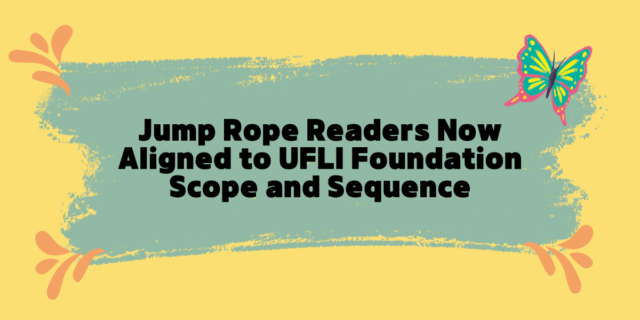
The following was written by Jump Rope Readers Series Editor Michael Rae-Grant.
As every K-2 teacher knows, small groups can make a big difference. In small groups, we can offer our young students lots of differentiation, feedback, and encouragement—all of which help them grow by leaps and bounds.
When it comes to teaching reading, small groups are an especially important tool in the K-2 teacher’s kit. Our readers often come to us with a wide range of skills, and even when the range is narrower, they inevitably learn new skills at different rates. In our small groups, we can meet all of our readers right where they are.
Decodable texts like the Jump Rope Readers can be a terrific resource for planning effective small group work. In this post, I’ll share a sample teaching sequence that you can use along with your Jump Rope Readers to plan small groups for students who are still learning foundational decoding skills.
Forming Small Groups
By “foundational decoding skills” I mean the skills necessary for decoding words with the six syllable types, as well as words with inflectional endings and two syllables. These skills are an excellent focus for the limited time we have with small groups: they can be practiced relatively quickly, and they enable students to access the intellectually and emotionally rich world of children’s literature—a huge payoff. For these reasons, the sequencing template I’m going to share contains a healthy dose of these skills, along with some comprehension work.
Before you dig into the sequencing template and begin planning your groups, you’ll want to assess where your students are when it comes to decoding. I recommend you use a decoding assessment like the one in the Heinemann Flight online resources for the Jump Rope Readers (Matching Students to Jump Rope Readers). Decoding assessments take just a few minutes to complete, and they offer a clear picture of the skills students have learned and the skills they are still learning.
Once you’ve finished with your assessments, form groups of students that will benefit from a similar instructional focus around decoding. Plan to keep your groups consistent across a cycle of instruction—for a few weeks or so, that is. This helps students get into the groove of working with their group, and it gives you time to teach into each group’s instructional focus. At the end of your cycle, plan to reassess and reshuffle your groups as necessary.
After your groups are formed, the next step is to match each with a series of Jump Rope Readers. For this, you can use the scope and sequence in the Guide to the Jump Rope Readers to find a series that fits the instructional focus you’ve identified for each group. If you’d like more detailed guidance, see the “Matching Students to Jump Rope Readers” document in the online resources.
Planning Small Groups
Once you’ve formed your groups and chosen a series of Jump Rope Readers for each, you can use the following sequencing template to plan small group work that supports both decoding and comprehension:
- Decoding practice
- Encoding practice
- Introduce the book
- Partner reading
- Brief discussion
Below I offer some guidance on how to use this sample teaching sequence along with your Jump Rope Readers. One of the best things about decodable texts like the Jump Rope Readers is that the books themselves contain almost all the content you need to plan effective small groups.
Decoding Practice—Sounds
For beginners, it’s helpful to work on skills in isolation before applying them in context. Think about soccer practice—the coach has players warm up with some passing and dribbling before sending them off to scrimmage. So to begin your small group, you’ll want students to warm up with some of the sounds and words from the book they’re about to read.
To practice their sounds, show students a deck of cards with recently taught letter-sound correspondences plus any that remain tricky. If helpful, use cards with picture mnemonics initially, but phase these out as students become more familiar with specific correspondences. Over time, the deck should feature more and more cards with letters only, as this is closer to the task of recognizing correspondences in print.
Each Jump Rope Reader features a “blue page” inside the front cover. This page lists all the letter-sound correspondences the book contains. You can use the “blue page” to quickly create a deck aligned with the book.
Decoding Practice—Words
When students fully decode a word several times, it enters their sight vocabulary. This is a big deal because as students grow their sight vocabulary, their fluency and their comprehension also improve.
To help students grow their sight vocabulary while also preparing them to read the book, select 8-10 phonetically regular words from your chosen Jump Rope Reader. Choose a majority that match your instructional focus for the group, but also choose some mixed review words. You can use the words from the “Read it!” activity inside the front cover as a starting set.
Decide whether to read the words “sound-by-sound” or as a whole word. Either way, it’s best if students read the words chorally, not round robin, because it offers the most practice.
Encoding Practice
Encoding practice is a powerful tool that supports growth in both reading and writing. Select 4-5 words from among those you’ve chosen for decoding practice. Then, use a simple dictation routine like the following:
- Say the word, use it in a sentence.
- Ask students to segment the word across their fingers.
- Prompt students to write the word.
- Show the correct spelling and ask students to fix up as necessary.
If your small group time is limited, you can alternate decoding and encoding practice each time you meet with a group.
Introduce the Book
Once students have warmed up their skills, it’s time to take on the book. To set them up for success, it’s helpful to offer a brief book introduction. A supportive introduction for a decodable text does three things: it prompts students to preview the book and make predictions, it briefly points out any non-decodable words the book contains, and it sets a purpose for reading.
The “Be a book buddy…” section inside the front cover of each Jump Rope Reader offers a suggested book introduction that you can use.
Partner Reading
After the book introduction, set students up to read with a partner. Partner reading offers extra support, and it helps students be accountable for reading all of the words. Depending on the amount of time available, partners can read the whole book or a section of it.
For the earliest readers, I like to use a routine in which partners share the same book and take turns being the “reader” and the “coach.” The reader reads the words aloud and the coach points under each word as it is read, helping with tricky words along the way. Partners switch roles when they turn the page.
For readers who are further along, I often give each partner a copy of the book. As before, one partner is the reader and the other is the coach. The coach follows along with their eyes and helps with tricky words. Again, partners switch roles when they turn the page.
As partners read, you can coach them on their decoding and their partner work, or you can ask questions to check for comprehension. Once students have gotten the hang of partner reading, you might consider leaving them with the task while you work with other students. If you do, be sure to set up an expectation for what the partners will do when they finish the book. For example, they might reread it independently or select another book from their bin.
Brief Discussion
The whole point of reading is to get at the meaning of a text, so it’s important that we always bring the focus back to comprehension—even when much of our instruction in K-2 is angled to help students with the central challenge of decoding.
So be sure to end your small groups with a brief discussion of the book you’ve selected. Each Jump Rope Reader features suggested discussion questions in the “Talk about…” section inside the back cover. You can use these questions to spark some conversation—and, of course, supplement as needed with questions of your own.
♦ ♦ ♦ ♦
So there you have it—a sequencing template you can use along with your Jump Rope Readers to plan small groups for students who are still learning foundational decoding skills. This sample teaching sequence is just a start, of course—no doubt you and your colleagues will think of ways to add variety and nuance!


